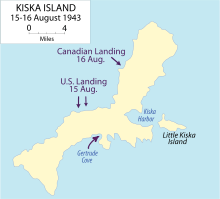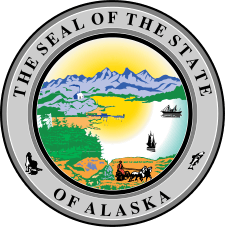Operation Cottage
| Operation Cottage | |||||||
|---|---|---|---|---|---|---|---|
 American troops landing on Kiska. | |||||||
| |||||||
| Belligerents | |||||||
|
(not present) | |||||||
| Commanders and leaders | |||||||
| N/A | ||||||
| Strength | |||||||
|
| N/A | ||||||
| Casualties and losses | |||||||
| Over 300 allied casualties[1] {approximately 309 casualties} | |||||||
| |||||||
Operation Cottage was a tactical maneuver which completed the Aleutian Islands campaign. On August 15, 1943, Allied military forces landed on Kiska Island, which had been occupied by Japanese forces since June, 1942. The Japanese, however, had secretly abandoned the island two weeks prior, and so the Allied landings were unopposed. Despite this, after over two days in thick fog and in a confused state of affairs, U.S. and Canadian forces mistook each other for the enemy. The brief firefight left 32 dead, with a further 50 wounded on either side and 130 trench foot wounds.[1] Allied forces suffered over 300 casualties in total during the operation, due to stray Japanese mines, friendly fire incidents, and the difficult terrain.
Background
The Japanese under Captain Takeji Ono had landed on Kiska at approximately 01:00 on June 7, 1942, with a force of about 500 Japanese marines. Soon after arrival, they stormed an American weather station. Here they killed two and captured eight United States Navy officers. The remaining eight were sent to Japan as prisoners of war. Another 2,000 Japanese troops arrived, landing in Kiska Harbor. At this time, Monzo Akiyama, a Rear-Admiral, headed the force on Kiska. In December 1942, additional anti-aircraft units, engineers, and a negligible number of reinforcement infantry arrived on the island. In the spring of 1943, control was transferred to Kiichiro Higuchi.
Invasion plan and execution

A Consolidated B-24 Liberator aircraft sighted Japanese ships in Kiska. No further identification was visible. To United States naval planners, none was necessary and the orders to invade Kiska soon followed.
Due to the heavy casualties suffered at Attu Island, planners were expecting another costly operation. The Japanese tactical planners had, however, realized the isolated island was no longer defensible and planned for an evacuation.
Although small, there were signs of Japanese retreat. Anti-aircraft guns, once active during the bombardment of Kiska, were silent when Allied planes flew over in the days leading up to the invasion.
On August 15, 1943, the 7th Division (U.S.) and the 13th Infantry Brigade (Canada), landed on opposite shores of Kiska.
Both U.S. and Canadian forces mistook each other as the Japanese and, as a result of friendly fire, 28 Americans and 4 Canadians were killed, with wounded on either side.[1] A stray Japanese mine caused the USS Abner Read (DD-526) to lose a large chunk of its stern. The blast killed 71 and wounded 47. 191 troops went missing during the two-day stay on the island and presumably also died from friendly fire, booby traps, or environmental causes. Four other troops had also been killed by landmines or other traps.
See also
- "Yank" Levy who trained many of these forces in guerrilla warfare.
Notes
- 1 2 3 "The Battle for Kiska", Canadian Heroes, canadianheroes.org, 13 May 2002,
Originally Published in Esprit de Corp Magazine, Volume 9 Issue 4 and Volume 9 Issue 5
References
- Feinberg, Leonard (1992). Where the Williwaw Blows: The Aleutian Islands-World War II. Pilgrims' Process, Inc. ISBN 0-9710609-8-3.
- Garfield, Brian The Thousand Mile War, Aurum Press, 1995 ISBN 1-84513-019-7
- Goldstein, Donald M.; Katherine V. Dillon (1992). The Williwaw War: The Arkansas National Guard in the Aleutians in World War. Fayettville, Arkansas, USA: University of Arkansas Press. ISBN 1-55728-242-0.
- Morison, Samuel Eliot (2001) [1951]. Aleutians, Gilberts and Marshalls, June 1942-April 1944, vol. 7 of History of United States Naval Operations in World War II. Champaign, Illinois, USA: University of Illinois Press. ISBN 0-316-58305-7.
- Perras, Galen Roger (2003). Stepping Stones to Nowhere, The Aleutian Islands, Alaska, and American Military Strategy, 1867 - 1945. Vancouver British Columbia: University of British Columbia Press. ISBN 1-59114-836-7.
External links
| Wikimedia Commons has media related to Aleutian Islands campaign. |
- Logistics Problems on Attu by Robert E. Burks.
- Operation Cottage at canadiansoldiers.com
- Aleutian Islands Chronology
- Aleutian Islands War
- Red White Black & Blue - feature documentary about The Battle of Attu in the Aleutians during World War II
- Soldiers of the 184th Infantry, 7th ID in the Pacific, 1943-1945
- World War II Campaign Brochure for Aleutian Islands from the United States Army Center of Military History.
- "Kiska".
- A film clip ALLIES TAKE KISKA ETC. (1943) is available at the Internet Archive

